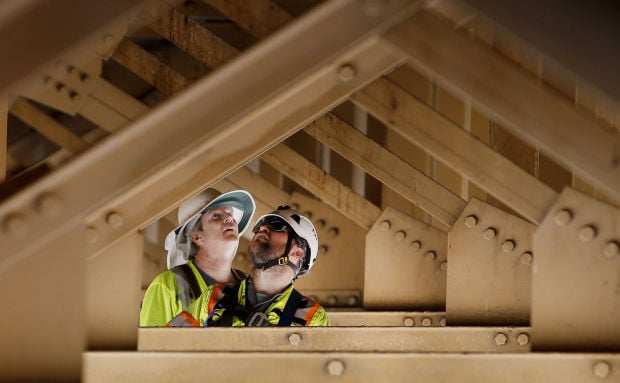Pima County officials are trying to put to rest claims that state-shared money for roads is used by the county for other purposes.
At issue is $40.6 million in gas tax revenue from the highway user revenue fund, or HURF, and $12.4 million in vehicle license tax revenue, or VLT, which makes up the lion’s share of the $55 million in revenue received by the county’s transportation department.
“We have heard claims that Pima County does not spend its HURF or VLT for transportation purposes,” County Administrator Chuck Huckelberry wrote in a March 21 memo to the Board of Supervisors.
“Such is incorrect,” he wrote. “Every dollar is spent to operate, maintain, and construct a transportation system; and with limited revenues, we struggle to provide the level of service of our neighboring counties to the north.”
The memo comes as 60 percent of the roads under Pima County’s purview are rated poor to failing and the county gears up for its annual budget discussions.
District 1 Supervisor Ally Miller said she disagreed with Huckelberry’s conclusions.
HURF money should be used on roadwork, but much of the revenue goes toward paying salaries and overhead in the transportation department, she said.
“The majority of these people are not out fixing our roads everyday,” Miller said. “They shouldn’t be paying their salaries with HURF money.”
The county should focus all of the revenue on road repair, minus the $18.6 million set aside for bond payments, she said.
Using HURF money to pay salaries is “exactly what Maricopa does, exactly what Pinal does,” Huckelberry said.
He noted Pima spends $20.1 million to compensate 293 transportation employees, compared with Maricopa paying $24.2 million for 416 employees. Pinal pays $10.4 million for 164 employees, according to a cost breakdown included in Huckelberry’s memo.
Pima’s maintenance and operations division spends $10.2 million. The county spends $5.5 million on administration and $3.5 million on engineering.
A comparison of Pima, Maricopa, and Pinal counties compiled by Pima County staff showed Maricopa spends $7.1 million on administration and Pinal spends $8.2 million.
Pima spends $69,000 for each full-time employee, while Maricopa spends $74,000 and Pinal spends $63,000.
Huckelberry said he issued the memo as “part of the process of getting factual information out and not letting the public be deceived about our ability or inability to operate a transportation system.”
Miller is creating a “myth” that county roads can be repaired without a tax increase or other new revenue source, Huckelberry said. “That’s simply not true.”
County residents already pay a half-cent sales tax dedicated for capital improvements, Miller said, but the revenue goes to the Regional Transportation Authority instead of repairing roads.
Huckelberry pointed to the outsized portion of state-shared money that goes to Maricopa.
While Pima receives $53 million to serve 353,000 people and maintain 2,300 miles of roads, Maricopa gets about $107 million to serve 284,000 people and 2,500 miles of roads. Pinal receives $25.2 million for 205,000 residents and 2,100 miles of roads.
“I could care less what Maricopa and Pinal are doing. Their roads are in good shape,” Miller said.
Maricopa receives more money because more gas is sold there, she said. In addition, Maricopa needs more money to maintain its roads because far more people drive on those roads than roads in Pima.
Looking closer to home, Miller said Oro Valley and Marana roads are in better shape than Pima County roads because the towns “live within their means” and use HURF money to repair roads.
Huckelberry noted Pima is paying off transportation bonds and puts $6.4 million toward transit and special needs, but neither Maricopa nor Pinal have those costs.
Down the road
- The right lane of westbound Interstate 10 will be closed for maintenance at West Orange Grove Road from 9 a.m. to 1 p.m. Thursday, March 31.
- The city of Tucson is holding an open house on the Broadway Improvement Project, which will widen Broadway to six lanes from Euclid Avenue to Country Club Road. Members of the public can go to Sabbar Shrine Temple, 450 S. Tucson Blvd, on Tuesday, March 29, at 5:30 p.m. to ask questions of officials with the city’s transportation department and the Regional Transportation Authority. If you can’t make it on Tuesday, the Tucson City Council will hold a hearing April 5 on the Broadway expansion.
In other road news, the Arizona Department of Transportation is planning major improvements to Arizona 86, also known as Ajo Way.
The road will be expanded to four lanes between West Valencia Road and South Sheridan Avenue. The urban section between Sheridan and South Kinney Road will become a six-lane highway.
The first stages of the $41-million project will begin in mid-April and include removing vegetation and earth to make way for new travel lanes.
The $40-million replacement of the I-19 interchange, which will include a wider bridge and consolidating traffic signals, is slated to start this spring.
The goal of the projects is to “add capacity while making it easier for motorists to navigate through this area, which is seeing tremendous growth,” ADOT engineer Rod Lane said in a news release.





